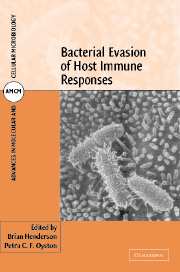Book contents
- Frontmatter
- Contents
- Contributors
- Preface
- Part I Recognition of bacteria
- 1 The dendritic cell in bacterial infection: Sentinel or Trojan horse?
- 2 CD1 and nonpeptide antigen recognition systems in microbial immunity
- 3 The NRAMP family: co-evolution of a host/pathogen defence system
- Part II Evasion of humoral immunity
- Part III Evasion of cellular immunity
- Index
- Plate section
- References
1 - The dendritic cell in bacterial infection: Sentinel or Trojan horse?
from Part I - Recognition of bacteria
Published online by Cambridge University Press: 13 August 2009
- Frontmatter
- Contents
- Contributors
- Preface
- Part I Recognition of bacteria
- 1 The dendritic cell in bacterial infection: Sentinel or Trojan horse?
- 2 CD1 and nonpeptide antigen recognition systems in microbial immunity
- 3 The NRAMP family: co-evolution of a host/pathogen defence system
- Part II Evasion of humoral immunity
- Part III Evasion of cellular immunity
- Index
- Plate section
- References
Summary
INTRODUCTION
Dendritic cells play a key role in the initiation and regulation of T-cell dependent immune responses. Much of their significance lies in their role as a cell linking the evolutionarily ancient innate immune system to the more complex and sophisticated adaptive immune system. Understanding their function in the context of bacterial infection, therefore, where the strands of innate and adaptive immunity are so closely interwoven, is likely to be particularly significant.
The cell biology of the dendritic cell poses a number of specific questions relating to bacterial physiology and pathophysiology. In particular, much of the literature in the field has been concerned either with understanding how dendritic cells process and present bacterial proteins in the context of a “particulate” as opposed to a “soluble” form, or with mapping the interactions between dendritic cells and bacterial cell wall components. This chapter first provides a brief overview of present understanding of the dendritic cell system and its role in immune responses, and then addresses questions relating more specifically to the interaction between dendritic cells and bacteria.
DENDRITIC CELLS AND THE IMMUNE RESPONSE
The dendritic cell family
T-cell recognition of antigen has a requirement for the antigen to be first processed and then presented by another cell, termed the “antigen presenting cell.” This requirement, first determined empirically, can now be understood in terms of the well-established model of T-cell recognition, involving the tripartite molecular interaction between T-cell antigen receptor, antigen peptide fragment, and MHC molecule (see Chapter 2 for more details).
- Type
- Chapter
- Information
- Bacterial Evasion of Host Immune Responses , pp. 3 - 20Publisher: Cambridge University PressPrint publication year: 2003

